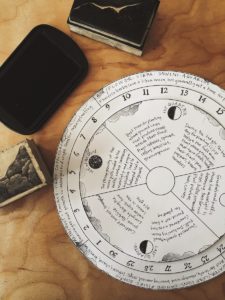I’ve been paying attention recently to an old gardening proverb that goes like this: “With the waxing of the Moon, the Earth exhales. With the waning of the Moon, the Earth inhales.”
Living here on the Outer Cape, it’s easy to be aware of how the Moon controls the rise and fall of the ocean — our tides are visible evidence of this ebb and flow. But what this proverb refers to is the way the Moon also affects water within the Earth.
That’s part of the idea behind the tradition of gardening by the Moon: to work in harmony with this natural cycle means planting on the days when water is pulled closer to the surface of the Earth and the light from the Moon is strong. Taking it a step further, some gardeners also follow the Moon’s astrological sign, noting its influence on gardening chores.

The Moon moves through the 12 astrological signs of the zodiac every two to three days. Each sign is associated with an element — water, earth, air, or fire — that is said to lend the days particular attributes. Water and earth signs are considered the most fertile ones — so, those are the times to plant, while air bodes well for harvesting. And, of interest right now, when the Moon is in a fire sign, that’s the time to weed.
As the moon moves through the signs of the zodiac, it does so in phases. As it’s waxing, moonlight is increasing, and as it wanes the light decreases. So, using an astrological calendar to determine when and what to plant or do in the garden requires referring both to what sign and to what phase the Moon is in.
A perpetual calendar is a handy way to keep all this information in one place. Cut three circles from heavyweight paper, each one about an inch or so bigger than the last. Stack the three circles and use a paper fastener in the center to attach them.
Gardening Notes by Phase
Divide the smallest circle of your calendar into four sections, one for each Moon phase (two waxing quarters and two waning ones), noting the new and full Moons. Add notes for each phase:
First Quarter: Increasing light initiates healthy leaf growth. Continue to plant above-ground crops, especially those that produce seeds outside their fruit: broccoli, spinach, lettuce, cauliflower.
Second Quarter: Strong moonlight leads to healthy leaf growth. Good for above-ground bearing annuals with seeds that form inside the fruit: tomatoes, melons, peppers, peas, beans, squash.
Full Moon: Gravitational pull is still strong, but decreasing moonlight forces energy down into the earth. Transplant or plant bulbs, perennials, root crops.
Third Quarter: Complete all planting before the last quarter begins.
Last Quarter: Decreased moonlight and gravitational pull. Time to prune, harvest, cultivate, fertilize. Mow the lawn. Weed in a fire sign.
New Moon: Plant above ground crops during this phase. The strong gravity of the moon pulls water to the surface.
Gardening Notes by Sign
The largest circle is for the astrological signs and their characteristics. Write your gardening notes along the outer edge of the circle. A little research in the Small Farmer’s Journal and other almanacs can yield more details, but these are the basics:
The water signs Cancer, Scorpio, and Pisces are the most fertile signs for planting. Best for leafy, above-ground bearing annual crops: lettuces, chard, spinach, brassicas.
The earth signs Taurus, Virgo, and Capricorn are thought to encourage root growth, so they’re good ones for planting underground crops and transplanting.
The air signs Libra, Gemini, and Aquarius are also considered the flower signs. Flowers and herbs love a Libra moon. Cultivate, harvest, can, and preserve in these signs.
The fire signs Aries, Leo, and Sagittarius are considered barren. Plant crops grown for their seed during these signs. Prune fruit trees. And, in Leo, weed.
Finally, the middle circle acts as the calendar; number this from 1 to 30 along the outer edge of the circle. To use your perpetual calendar, line up the date, Moon phase, and sign to reveal the garden chores for that day.



